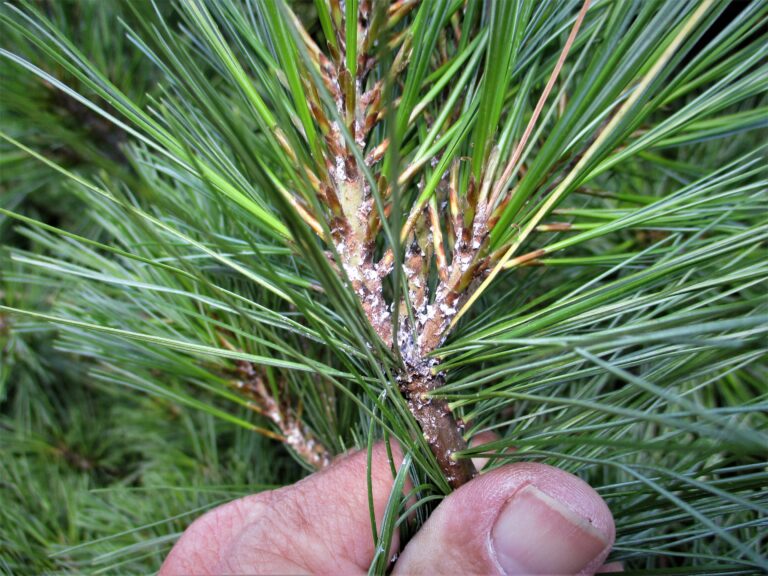Pine Bark Adelgid (Pineus strobi)
GDD Window (base 50): 25-100
Overview:
- 1/16″ long, soft-bodied, aphid-like insects. Adult females are bluish-green, covered with cottony, waxy strands.
- Overwinter as partially grown females, maturing into stem mothers in early spring.
- Stem mothers lay 100-200 oval, brown eggs with a coating of woolly wax around budbreak.
- Eggs hatch and brownish black nymphs feed on new needles, creating green, cone-shaped galls which develop around the insects who continue to feed inside of them.
- In late summer, galls dry out and turn brown, open, and mature nymphs emerge, developing into winged females who will lay more eggs, which hatch into overwintering nymphs.
- Causes branch thinning and dieback, weakening stems
- Host plants: Norway and white spruce, occasionally red and Colorado blue spruce
Management:
Cultural Practices:
- Kill young stages before galls can form. Once galls form, insecticides won’t work and pruning is the only option.
- Remove infested twigs and branches
- Remove galls before they dry and turn brown
- Consider removing severely infested trees to protect other trees
- Ensure optimal tree health to reduce stress
- Plant trees with generous spacing
Materials:
- Contact insecticides:
- Avermectins [6]: Abamectin
- Pyrethroids [3]: –thrins
- Systemic insecticides:
- Tetronics [23]: Spirotetramat
- Neonicotinoids [4A]: Imidacloprid, Thiamethoxam, Dinotefuran,
- Organophosphates [1B]: Acephate
- Diamides [28]: Cyantraniliprole
- Considerations:
- Use with caution. Can harm beneficial insects and lead to resistance if overused. Apply before gall formation.
Biorationals:
- Insecticidal soaps
- Will not kill eggs
- Horticultural oils
- Mineral oil, neem oil
- Will kill eggs
- Apply before bud break, or after galls have opened but before adelgids move to alternate hosts.


Disclaimer – Materials do not cover all possible control scenarios and are intended for licensed professionals. Tradenames do not imply endorsement and are used as examples. You must strictly follow the label for each compound prior to use. Rutgers is not responsible form is used materials or damages thereof. The label is the law. Labels will provide detailed information on use and restrictions. Additionally, application intervals, compatibility, surfactant use, PHI, PPE, important and other key information is described in detail. Always discuss treatments with your local agents. Note: Neonicotinoids can only be legally applied in commercial agriculture settings by licensed applicators. Guidelines and recommendations made in this presentation are specific to the state of New Jersey.
